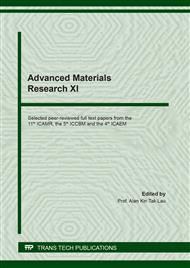p.13
p.21
p.31
p.39
p.45
p.51
p.61
p.67
p.73
Engineering Modified Mesoporous Silica Catalysts through Porosity and Surface Acidity Control for Selective Production of DME
Abstract:
DME has been received the attention as a renewable energy due to its thermal efficiencies equivalent to diesel fuel, lower NOx emission, near-zero smoke and non-toxic. DME can be obtained by methanol dehydration over solid acid catalysts or directly from syngas over bifunctional catalysts. The catalytic dehydration of methanol to DME has been widely studied in the literature over pure or modified γ -aluminas (γ-Al2O3) and zeolites. Mesoporous silica has obtained much consideration due to its well-defined structural order, high surface area, and tunable pore diameter. In this work, sulfonic acid and aluminium modified mesoporous silica were synthesized and tested as catalysts for production of dimethyl ether from methanol. The modified silicas were studied utilizing XRD, N2 physisorption, pyridine adsorption, and scanning electronic microscopy. The effects of reaction temperature and water deactivation on the methanol selectivity and conversion to dimethyl ether were investigated. Sulfonic acid modified mesoporous silica showed higher selectivity and stability of DME than that of aluminosilicate. The grafting of mesoporous silica with sulfonic groups displayed much more enhanced hydrothermal stability than Al-MCM-41 and γ-Al2O3.
Info:
Periodical:
Pages:
45-49
Citation:
Online since:
July 2021
Keywords:
Price:
Сopyright:
© 2021 Trans Tech Publications Ltd. All Rights Reserved
Share:
Citation:


